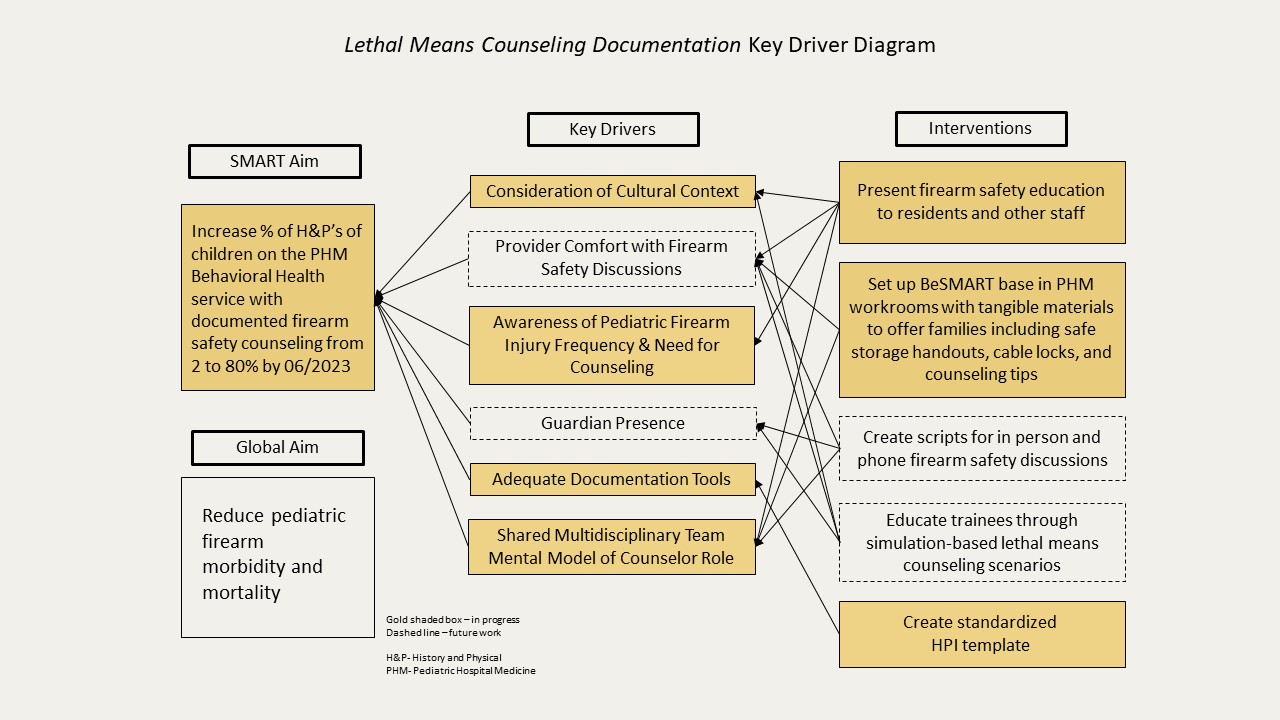Injury Prevention
Injury Prevention 2
318 - Improving Lethal Means Counseling Documentation for Youth Admitted to A Pediatric Behavioral Health Service
Publication Number: 318.42

Kelsey Gastineau, MD (she/her/hers)
Clinical Fellow, Pediatric Hospital Medicine
Monroe Carell Jr. Children's Hospital at Vanderbilt
Nashville, Tennessee, United States
Presenting Author(s)
Background:
Safe firearm storage reduces the risk of firearm suicide, an increasing problem for US youth. Physician counseling combined with the provision of a tangible tool (e.g. cable lock) increases safe storage of firearms.
Objective: Increase lethal means counseling during the history and physical (H&P) for children admitted with psychiatric concerns at Monroe Carell Jr Children’s Hospital at Vanderbilt from 2% to 80% by June 30, 2023.
Design/Methods:
A multidisciplinary team created a key driver diagram based on our stated aim (Figure 1). All children admitted to the Behavioral Health service were included. Children transferred from another medical team were excluded. The primary measure was lethal means counseling defined as the percentage of H&Ps with documentation including the terms “gun”, “firearm”, or “lethal means” AND “counseling”. Twenty charts were reviewed per week and identified using a random number generator to determine the first 20 to review. Weeks were combined if < 20 patients were admitted in a week. Data were analyzed using statistical process control charts in weekly cohorts. Initial interventions included informal and formal didactics to trainees as well as having educational materials and storage devices available to provide to families. In June, standardized language was added to an admission template and shared to all pediatric residents and the safe storage were added to all hospital medicine work rooms. In October 2021, a lethal means counseling training session was added to the beginning of each monthly educational block taught by the Behavioral Health Nurse Practitioner.
Results:
There were 1100 total encounters included from July 2020-December 2022. Baseline mean lethal means counseling from August-December 2021 was 1.8% (n = 340). Special cause variation with 8 points above the mean line resulted in a centerline shift from a mean of 1.8% to 20.5% in mid-March following the educational interventions. A second shift was observed following the monthly training sessions to 37.5% with two points in the outer third of the control limits and a third point outside the control limits (Figure 2).
Conclusion(s):
Initial interventions of trainee education and distribution of family education and storage devices led to an increase in lethal means counseling documentation. More consistent educational sessions led to a second shift, however still under our goal of 80%. Educational interventions are less likely to result in a substantial or lasting change to our system. Next steps will include simulation to improve comfort with discussions and solutions to nighttime admissions.
.png)
